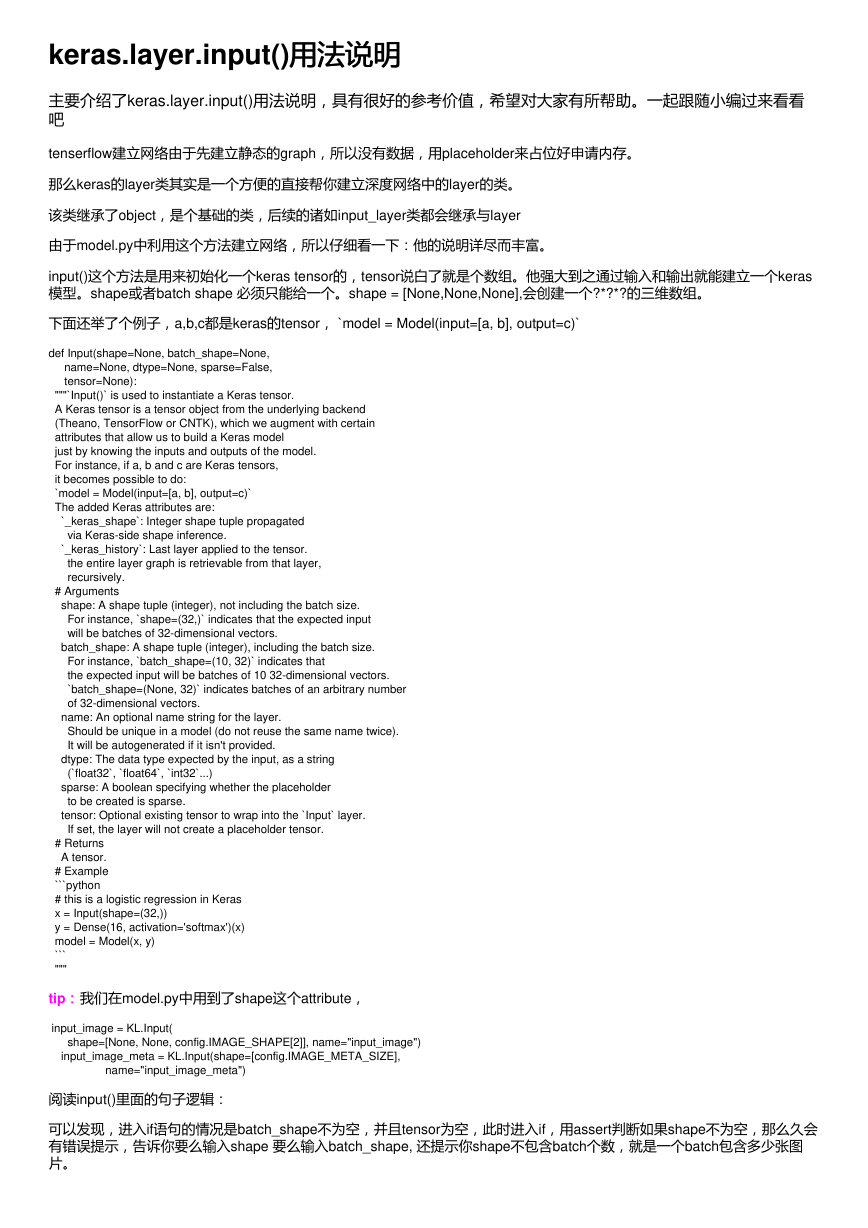keras.layer.input()用法说明
用法说明
主要介绍了keras.layer.input()用法说明,具有很好的参考价值,希望对大家有所帮助。一起跟随小编过来看看
吧
tenserflow建立网络由于先建立静态的graph,所以没有数据,用placeholder来占位好申请内存。
那么keras的layer类其实是一个方便的直接帮你建立深度网络中的layer的类。
该类继承了object,是个基础的类,后续的诸如input_layer类都会继承与layer
由于model.py中利用这个方法建立网络,所以仔细看一下:他的说明详尽而丰富。
input()这个方法是用来初始化一个keras tensor的,tensor说白了就是个数组。他强大到之通过输入和输出就能建立一个keras
模型。shape或者batch shape 必须只能给一个。shape = [None,None,None],会创建一个?*?*?的三维数组。
下面还举了个例子,a,b,c都是keras的tensor, `model = Model(input=[a, b], output=c)`
def Input(shape=None, batch_shape=None,
name=None, dtype=None, sparse=False,
tensor=None):
"""`Input()` is used to instantiate a Keras tensor.
A Keras tensor is a tensor object from the underlying backend
(Theano, TensorFlow or CNTK), which we augment with certain
attributes that allow us to build a Keras model
just by knowing the inputs and outputs of the model.
For instance, if a, b and c are Keras tensors,
it becomes possible to do:
`model = Model(input=[a, b], output=c)`
The added Keras attributes are:
`_keras_shape`: Integer shape tuple propagated
via Keras-side shape inference.
`_keras_history`: Last layer applied to the tensor.
the entire layer graph is retrievable from that layer,
recursively.
# Arguments
shape: A shape tuple (integer), not including the batch size.
For instance, `shape=(32,)` indicates that the expected input
will be batches of 32-dimensional vectors.
batch_shape: A shape tuple (integer), including the batch size.
For instance, `batch_shape=(10, 32)` indicates that
the expected input will be batches of 10 32-dimensional vectors.
`batch_shape=(None, 32)` indicates batches of an arbitrary number
of 32-dimensional vectors.
name: An optional name string for the layer.
Should be unique in a model (do not reuse the same name twice).
It will be autogenerated if it isn't provided.
dtype: The data type expected by the input, as a string
(`float32`, `float64`, `int32`...)
sparse: A boolean specifying whether the placeholder
to be created is sparse.
tensor: Optional existing tensor to wrap into the `Input` layer.
If set, the layer will not create a placeholder tensor.
# Returns
A tensor.
# Example
```python
# this is a logistic regression in Keras
x = Input(shape=(32,))
y = Dense(16, activation='softmax')(x)
model = Model(x, y)
```
"""
tip::我们在model.py中用到了shape这个attribute,
input_image = KL.Input(
shape=[None, None, config.IMAGE_SHAPE[2]], name="input_image")
input_image_meta = KL.Input(shape=[config.IMAGE_META_SIZE],
name="input_image_meta")
阅读input()里面的句子逻辑:
可以发现,进入if语句的情况是batch_shape不为空,并且tensor为空,此时进入if,用assert判断如果shape不为空,那么久会
有错误提示,告诉你要么输入shape 要么输入batch_shape, 还提示你shape不包含batch个数,就是一个batch包含多少张图
片。
�
那么其实如果tensor不空的话,我们可以发现,也会弹出这个提示,但是作者没有写这种题型,感觉有点没有安全感。注意点
好了
if not batch_shape and tensor is None:
assert shape is not None, ('Please provide to Input either a `shape`'
' or a `batch_shape` argument. Note that '
'`shape` does not include the batch '
'dimension.')
如果单纯的按照规定输入shape,举个例子:只将shape输入为None,也就是说tensor的dimension我都不知道,但我知道这
是个向量,你看着办吧。
input_gt_class_ids = KL.Input(
shape=[None], name="input_gt_class_ids", dtype=tf.int32)
就会调用Input()函数中的这个判断句式,注意因为shape是个List,所以shape is not None 会返回true。同时有没有输入
batch_shape的话,就会用shape的参数去创造一个batch_shape.
if shape is not None and not batch_shape:
batch_shape = (None,) + tuple(shape)
比如如果输入:
shape = (None,)
batch_shape = (None,)+shape
batch_shape
#会得到(None, None)
可以发现,这里要求使用者至少指明你的数据维度,比如图片的话,是三维的,所以shape至少是[None,None,None],而且我
认为shape = [None,1] 与shape = [None]是一样的都会创建一个不知道长度的向量。
以上这篇keras.layer.input()用法说明就是小编分享给大家的全部内容了,希望能给大家一个参考,也希望大家多多支持我们。
�




 2023年江西萍乡中考道德与法治真题及答案.doc
2023年江西萍乡中考道德与法治真题及答案.doc 2012年重庆南川中考生物真题及答案.doc
2012年重庆南川中考生物真题及答案.doc 2013年江西师范大学地理学综合及文艺理论基础考研真题.doc
2013年江西师范大学地理学综合及文艺理论基础考研真题.doc 2020年四川甘孜小升初语文真题及答案I卷.doc
2020年四川甘孜小升初语文真题及答案I卷.doc 2020年注册岩土工程师专业基础考试真题及答案.doc
2020年注册岩土工程师专业基础考试真题及答案.doc 2023-2024学年福建省厦门市九年级上学期数学月考试题及答案.doc
2023-2024学年福建省厦门市九年级上学期数学月考试题及答案.doc 2021-2022学年辽宁省沈阳市大东区九年级上学期语文期末试题及答案.doc
2021-2022学年辽宁省沈阳市大东区九年级上学期语文期末试题及答案.doc 2022-2023学年北京东城区初三第一学期物理期末试卷及答案.doc
2022-2023学年北京东城区初三第一学期物理期末试卷及答案.doc 2018上半年江西教师资格初中地理学科知识与教学能力真题及答案.doc
2018上半年江西教师资格初中地理学科知识与教学能力真题及答案.doc 2012年河北国家公务员申论考试真题及答案-省级.doc
2012年河北国家公务员申论考试真题及答案-省级.doc 2020-2021学年江苏省扬州市江都区邵樊片九年级上学期数学第一次质量检测试题及答案.doc
2020-2021学年江苏省扬州市江都区邵樊片九年级上学期数学第一次质量检测试题及答案.doc 2022下半年黑龙江教师资格证中学综合素质真题及答案.doc
2022下半年黑龙江教师资格证中学综合素质真题及答案.doc